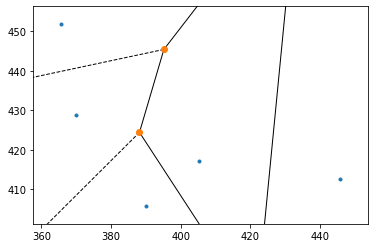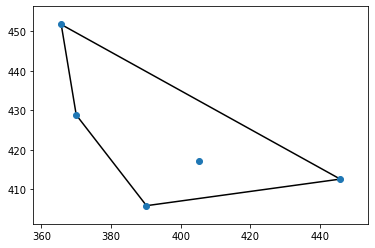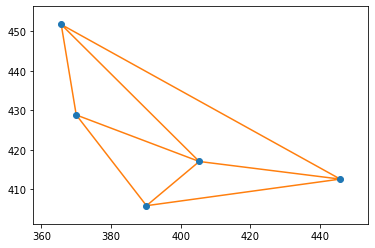Spatial analysis¶
[1]:
import movekit as mkit
import numpy as np
import pandas as pd
import matplotlib.pyplot as plt
from scipy.spatial import Voronoi, voronoi_plot_2d, convex_hull_plot_2d, delaunay_plot_2d
[5]:
path = "datasets/fish-5-cleaned.csv"
data = mkit.read_data(path)
data = mkit.extract_features(data)
data.head()
Extracting all absolute features: 100%|██████████| 100.0/100 [00:01<00:00, 81.44it/s]
[5]:
| time | animal_id | x | y | distance | direction | turning | average_speed | average_acceleration | stopped | |
|---|---|---|---|---|---|---|---|---|---|---|
| 0 | 1 | 312 | 405.29 | 417.76 | 0.0 | (0.0, 0.0) | 0.0 | 0.210217 | -0.006079 | 1 |
| 1 | 1 | 511 | 369.99 | 428.78 | 0.0 | (0.0, 0.0) | 0.0 | 0.020944 | 0.000041 | 1 |
| 2 | 1 | 607 | 390.33 | 405.89 | 0.0 | (0.0, 0.0) | 0.0 | 0.070235 | 0.000344 | 1 |
| 3 | 1 | 811 | 445.15 | 411.94 | 0.0 | (0.0, 0.0) | 0.0 | 0.370500 | 0.007092 | 1 |
| 4 | 1 | 905 | 366.06 | 451.76 | 0.0 | (0.0, 0.0) | 0.0 | 0.118000 | -0.003975 | 1 |
Spatial Objects¶
The function below produces three types of spatial objects: Voronoi-Diagrams, Convex Hulls and Delaunay Triangles. Optionally, one may obtain only group-specific outputs - one object per time-capture. These spatial objects may be used for a set of attributes, which are described below in detail. To get the full functionality of all attributes, please go to https://docs.scipy.org/doc/scipy-0.14.0/reference/tutorial/spatial.html.
[6]:
spatial_obj = mkit.get_spatial_objects(data, group_output = True)
spatial_obj.head()
Calculating spatial objects: 100%|██████████| 1000/1000 [00:15<00:00, 63.51it/s]
[6]:
| time | convex_hull_object | voronoi_object | delaunay_object | convex_hull_volume | voronoi_volume | |
|---|---|---|---|---|---|---|
| 0 | 1 | <scipy.spatial.qhull.ConvexHull object at 0x7f... | <scipy.spatial.qhull.Voronoi object at 0x7ff88... | <scipy.spatial.qhull.Delaunay object at 0x7ff8... | 1519.44120 | inf |
| 1 | 2 | <scipy.spatial.qhull.ConvexHull object at 0x7f... | <scipy.spatial.qhull.Voronoi object at 0x7ff88... | <scipy.spatial.qhull.Delaunay object at 0x7ff8... | 1528.95525 | inf |
| 2 | 3 | <scipy.spatial.qhull.ConvexHull object at 0x7f... | <scipy.spatial.qhull.Voronoi object at 0x7ff88... | <scipy.spatial.qhull.Delaunay object at 0x7ff8... | 1539.23800 | inf |
| 3 | 4 | <scipy.spatial.qhull.ConvexHull object at 0x7f... | <scipy.spatial.qhull.Voronoi object at 0x7ff88... | <scipy.spatial.qhull.Delaunay object at 0x7ff8... | 1549.61380 | inf |
| 4 | 5 | <scipy.spatial.qhull.ConvexHull object at 0x7f... | <scipy.spatial.qhull.Voronoi object at 0x7ff88... | <scipy.spatial.qhull.Delaunay object at 0x7ff8... | 1560.33905 | inf |
Producing a voronoi diagram¶
Each timestep gets a voronoi object as well as the area of the voronoi - shape. Infinity, if respective animal is outmost in swarm.
Voronoi object contains the following attributes:
pointsCoordinates of input points.verticesCoordinates of the Voronoi vertices.ridge_pointsIndices of the points between which each Voronoi ridge lies.ridge_verticesIndices of the Voronoi vertices forming each Voronoi ridge.regionsIndices of the Voronoi vertices forming each Voronoi region. -1 indicates vertex outside the Voronoi diagram.point_regionIndex of the Voronoi region for each input point. If qhull option “Qc” was not specified, the list will contain -1 for points that are not associated with a Voronoi region.furthest_siteTrue if this was a furthest site triangulation and False if not.
Producing a convex hull¶
Similar to voronoi-diagram, also the convex hull is of interest for movement-related data. Additionally, a set of attributes may be attached to the convex hull objects. Examples are:
points(array of ints) Coordinates of input pointsvertices(array of ints ) Point indices forming the veritces of the convex hullareaArea of the convex hull.volumeVolume of the convex hull.
Producing Delaunay-triangles¶
Examples for attributes of interest consist of:
transformAffine transform from x to the barycentric coordinates c.vertex_to_simplexLookup array, from a vertex, to some simplex which it is a part of.convex_hullVertices of facets forming the convex hull of the point set.vertex_neighbor_verticesNeighboring vertices of vertices.points(ndarray of double, shape (npoints, ndim)) Coordinates of input points.simplices(ndarray of ints, shape (nsimplex, ndim+1)) Indices of the points forming the simplices in the triangulation. For 2-D, the points are oriented counterclockwise.neighbors(ndarray of ints, shape (nsimplex, ndim+1)) Indices of neighbor simplices for each simplex. The kth neighbor is opposite to the kth vertex. For simplices at the boundary, -1 denotes no neighbor.
Plotting all spatial objects at the 3rd timestep.¶
[7]:
# Plot all scipy - spatial objects of a given timestamp
voronoi_plot_2d(spatial_obj.voronoi_object[2])
convex_hull_plot_2d(spatial_obj.convex_hull_object[2])
delaunay_plot_2d(spatial_obj.delaunay_object[2])
plt.show()



[ ]: